| Author | Message | |||||
Humancafe |
This page is dedicated to the great human migrations of prehistory, carried into today. How do these mass migrations around the globe impact societies? Who came to the Americas first? Why do large numbers of people move from country to country, continent to continent? Is it for food alone? Why do people move? List of forum links used during The Group presentation, Mar. 8, 2011: Starting with http://www.humancafe.com/discus/messages/88/446.html Indian Kumeyaay rock art may have been about "puberty rites", but not as earlier believed, more like "educational" messages to the young on how to survive in the desert - per our Group's discussion. -- Ivan | |||||
Ivan/Kumeyaay6 |
Kumeyaay Indians (Kumiai in Spanish) of Anza-Borrego Desert, California  (interactive - click image for oral 'myths') (interactive - click image for oral 'myths') When I was crossing the Anza-Borrego desert a few days ago, on my way back from Salton Sea, California, I had occasion to turn off on Mine Wash Road, off Rte. 78 (on left, a few miles before -second- turn off to Borrego Springs) and drove in on the sandy road for a couple of miles to a site where the Kumeyaay Indian wintered in ancient times. The place is well marked with mortero holes. The settlement was nestled amid the rocks of the tail end of a mountain that ends here at a large wash. There is a California State Park sign marking the site, and then it is a very short walk through the large boulders to find morteros in several locations. My purpose for this detour, that sunny afternoon, was to check to see if I can again spot the large squarish "red flags" in the stones above this settlement, as I had discovered at (1)Pictograph Rock, as I had described finding there earlier. In both places, here and there, were Indian villages used by the Kumeyaay for centuries, mostly during the winter rainy season, while they summered up in the mountains around Laguna peak. I had later discovered they marked suitable stone shelters and habitations with large flaked off red markers, as earlier described. So I went to see here, while the light was still good, to see if I could find similar markers, now that I understood what they appeared to be. And indeed, there were two of them higher up the rocks, both faced about north-northwest, so they were visible from the valley floor at a distance. There were also some lesser such peeled off red rock formations, but they were too irregular and small, so those I ignored. (In fact, such red rock formations are rather rare anyway, but rectangular ones are non-existent except where they were made that way intentionally by the hand of man.) My interest was in finding the ones that had indication of being man made, especially by the regularity of their rectangular like shapes. If these markers were common to the Kumeyaay, then they should be visible above any rock formations where one could find shelter from the elements, and more importantly, water. Much to my surprise, the two markers were more to the left of where I had explored this site before. I had climbed up a large rock fall arroyo, in part looking to see where it went, but also in part to find any possible source of water. Since this end of the mountain seemed to drain here, I thought it likely. In fact, I found bobcat scat, lots of coyote and big horn sheep prints, but no water. Except for a few bees, one would never guess water was here, up that arroyo that eventually opens up into a small valley. But the red markers were to the left of this rock fall, over a smaller and steeper rock fall. So this was where I climbed up this time, water bottle and binoculars in hand, to see what I could find. The weather was not too hot, and having a belly full of chili reyenos and beans from El Menudo at Salton City, I figured I could last a couple of hours of hiking and climbing. This site has fewer morteros, but it has large boulders up the hill that are surprisingly easy to reach, since in places where the climb was difficult someone had the good sense to put large boulders, almost like a natural staircase. I had encountered similar 'stairs' over by Pictograph Rock, so knew what this was, and grateful for it. It made the climb easier, and I suspected the Indians put them there for that reason. When I got to the big boulders up there I was surprised to see that down beneath them was a warren of caves. One cave was large enough with a fat stone slab in it to have served as a natural kiva, while another cave had a nice nicho carved into one stone wall just next to a natural chimney for fire. All these caves, and here were lots of them, had animal scat in them, either coyote or desert hare, but well dried out.* This had been an especially dry year, and except for spots where a shower fell and things were green, the ocotillos were uncommonly black. There were stone lying about, but not of the kind I found earlier at a 'manufacturing' site, which had hard river stones broken up into flakes, some of which were discarded 'failed' arrowheads (the tips were broken), or other scraping and cutting tools. I actually found an Indian "Swiss army knife" of stone, which held very comfortably in the right hand to either cut, or skin or scrape bone, or chip arrowheads with. No pottery here, but I didn't look hard. But in the caves were only stones fallen from above, or perhaps a mano grinding stones. They 'felt' lived in, though no artifacts of anykind were visible. However, a couple of caves had clear indication of water coming down the sides, especially one with a large horizontal crack from which the stains of water emerged, though at present they were dry. Inside the caves it was cool. And outside, I believe near the large 'kiva' cave, there was a flat soft granite rock with three large irregular bowls in them, the kind to catch rainwater. So they were here too, and probably more inhabiting this site than down where the morteros were more common, as a place of habitation and water. My impression, as I clambered up and down these rocks, was that the Kumeyaay must have been small and nimble people to negotiate these places so well. Some of the entrances to these caves were small, but large enough for me to get in, and I am of medium height. Also, I found at times handy footholds, and handholds, to ease my climb. Though they looked natural enough, I suspect again the hand of man, because of where they were. All in all, I was pleased, and as the sun set behind the western mountains, I felt once again I connected with these ancient people who once upon a time lived and hunted, and loved and fought, here. I wonder how many there were? Judging from these labyrinthine caves, most of which were comfortable to stand in, there must have been at least 60 or more, at this site alone. One last observation: it seems that the stone caps lifted or peeled off to show the red pigment underneath were left in situ, almost as if they could easily be placed back again. If the area was potentially under attack from hostile tribes, that's what I would do, cover up the red markers. Until it rains, all this is still speculations, since I must find their water holes. [Ps: I wrote a story, very spontaneously, called "Ipi of the Desert", about a Kumeyaay boy's journey into manhood, 30 pages, which can be found here: http://www.humancafe.com/discus/messages/6/23.html#POST4148 ] Ivan *(Be extra cautious to NOT touch any mouse droppings because this area has had Hanta virus in places, so very dangerous, a tough illness you do not want and with high mortality.) | |||||
Ivan/native contact |
Was Medieval Catholic Church in North America, 1498?  (interactive) (interactive) The Cantino planisphere of 1502 shows the line of the Treaty of Tordesillas. LiveScience- history: Mystery Surrounds Possible Oldest Church in North America
If the Cantino of 1502 shows the line drawn by Pope Alexander VI in 1494, then it may not be such a strange story that a small band of Italian monks accompanied John Cabot north to Newfoundland. The real proof would be likely found inside the Vatican archives (like the recent 700 year secret archives of the Knights Templar trials revealed), or else the other real evidence lies buried under the township of Carbonear, which may harbor the remnants of the church of San Giovanni a Carbonare hidden there. The article further says: The truth may be hidden beneath meters of soil there. Were North American native Americans exposed to European civilization, and perhaps disease, much sooner than assumed? We know what happened in Mexico and southern America, but what about northern America? It might have ushered the very first great European migration to North America. I remember in New England there was anecdotal evidence of earlier European contact amongst the native Indians. Some native people found by the early colonists had blue eyes, though this was hushed up by the English in order not to contest their claim of New England for the Crown. Any possibility this was true? When I used to explore along the shores of the Merrimack river on the Massachusetts and New Hampshire border, I remember finding large man made stone caves, which local lore said belonged to the Vikings. It may be that they were really early English, or French, or some other now forgotten group that traveled through there, perhaps Basque fishermen or fur traders. In any case, North American Indians might have had contact with the Old World earlier than assumed, before the Mayflower at Plymouth Colony, or Jamestown, Virginia, and European colonization may need to be rewritten. Between the Culdee monks and Columbus, and later colonists, there could have been activity, some perhaps centuries if not millennia earlier. Who were the first European Americans?  Ninigret, chief of the Narragansett tribe, 1681. Ivan | |||||
Ivan/thanksgiving |
Happy Thanksgiving to Everyone - 2007  The American wild turkey Thank God we live in America, the first nation of Freedom in the world. Thank You to all Native Americans, who helped us in time of need. To become a great nation took many together, with the genius of a few. God Bless America, and all the strong, virtuous people who made it so. We live in Freedom under God, because of you. Ivan | |||||
anonymous |
"300" ! - meant as funny.  http://www.youtube.com/watch?v=l7qKD-Ph7ds&feature=related | |||||
Ivan/Kumeyaay9 |
Kumeyaay Rock Art - cross referenced  Pictograph Rock Art, Little Blair Valley, Anza-Borrego Desert, CA Pictographs at Anza Borrego desert, California - deciphered? - July 22, 2007 An in situ investigation of Pictograph Rock Art in Little Blair valley, Anza-Borrego Desert, southern California - August 6, 2007 'Red Flags' in Anza-Borrego Desert - August 26, 2007 Photo of 'red flags' - February 16, 2008 Ivan [Ps: I can't find any online references to the type of ladder shown in the Pictograph (looks like a lizard next to rock fall chevron markings), and perhaps none have survived into modern times. I call it a 'rock ladder' because it has long handles at the top to make it easily cantilevered and pulled up, and the bottom comes to a point, so to better jam it in between rocks or on sand. This is a very sensible design for a people who had to climb over big boulders (and I know this for a fact!), to have such a light weight ladder available and easily transportable to where it is needed at the time. Too bad if none survived in any museum anywhere, not even at Acoma, NM., into modern times.] | |||||
Ivan/rock ladders |
Pueblan people, kiva ladder, or 'rock ladder' of the Southwest.  Taos, NM, kiva ladder (interactive) Note how the ladder in the picture curves inwards at the bottom? But is long handled at the top? Just like the image of 'ladder' in Pictograph Rock, Little Blair Valley, Anza-Borrego Desert.  Navajo cornfield (interactive) Note how the small corn crops look like 'dots' on the landscape? Just like in the picture drawn, where there are rows of dots, which I believe signify crops. (See recent article on Return of the Corn to India pueblos.) These, in my opinion, are the images the artist saw at Pictograph Rock. We just don't see these things anymore, so have a hard time relating to them. But back then they were common images. Any desert clan passing through would have known exactly what it all meant! [See more info on 'rock ladders' in earlier post here: http://www.humancafe.com/cgi-bin/discus/show.cgi?tpc=6&post=3976#POST3976 ] Ivan | |||||
Ivan/Brazil tribe |
Uncontacted tribes in remote jungle areas still exist.  (interactive) (interactive) Isolated tribe spotted in Brazil -BBC News - more pix in link
These unnamed people appear healthy, but in danger of modern disease and destruction if encountered by visitors from outside. It would be tragic to lose these 'first Americans' if their lives and way of life perished through contact. But is it inevitable? Or can some accommodations be made to leave them in peace to themselves? This will prove a new challenge for this century. Ivan | |||||
Ivan/Pictograph Rock 2 |
Leaning Tower Rock and Pictograph Art. Discovery is a chance thing, but sometimes you feel you are guided to it. I had been thinking deeply on the Kumeyaay Rock Art in Little Blair Valley of the Anza-Borrego Desert, southern California, for past several weeks, so I finally decided to go there, Saturday 27 September, 2008, and explore it again. This time I was drawn to the 'red flags' of the northeastern part of the valley (about two miles walking), so went back to where I had seen one before (#2) across the northern end of the small valley. When I got there, shortly afternoon, and after an encounter with bees at the car park which got my adrenalin going, I walked along the edge of the valley. What I had failed to notice on my last trip was that about 50 paces to the right of the large rock shelter (marked with red flag) there was a rather large flat stone, which could have served well as a base for a sweat lodge in ancient times, and just to the left of it was another rock shelter. This shelter is below a very large rock, had a sandy floor and low overhead, but could have served its purpose as a dry sleeping place since it was deep under the rock. Above the entrance to this shelter was a small hammered out 'flag' though not square (looked like Corsica), nor red, but it had clear hammer marks around it. This led me to think that this part of the valley may have served multiple purposes, either as a hunting base camp, or perhaps the outer boundary of a more settled habitation. So looking out for more 'red flags' I set off to the northeastern part of this little valley to explore some more. At the northern end, there are two smaller valleys, one to the right and the other to the left. Since I was approaching the one to the right, and it was a hot day (100F+), I set off for a large tilted rock, which looked like a 'leaning rock tower', that promised shade. When I got there, beneath the tilted overhang there was a place to sit in the shade, which felt welcome. I examined some detritus stones laying about and realized they may have been chipped into arrowheads but abandoned, since they seemed incomplete. I gathered up about a half dozen and placed them on a flat stone, when I suddenly realized there were three mortero holes on it. That was a find! It meant people had lived here. So I poured some water from my spare canteen to see if it might attract life, a kind of offering to the wilderness. As I sat there in the shade, I looked up at the large rock wall, though I had looked at it before, magically before my eyes it was now filled with pictograph images! I could not believe what I saw, they were very faint, but of the same red paint used on the other Pictograph Rock at the southern end of the valley. Here was evidence that humans had lived here, and made their rock art magic on the large leaning overhanging stone. Not having a camera, but carrying some paper and pen, I quickly sketched what I saw:  The painted 'hand' on lower left was slightly smaller than my own. Hand of the artist? All the colors in the patterns were in red, and they were much faded. If there had been yellow used, as in the other rock, it may have faded away by now. Standing back from it at a distance, I could see a large crack in the top, where the front portion had separated from the back and was now precariously resting against another rock. Some old earthquake no doubt dislodged it, and there was clear evidence of water flowing down the rock face, especially on the right side. At the top was what looked like a large bowl, now split in two, which may have pooled rainwater in ancient times. But the images on the rock face were stunning. To the far right was clearly a ladder. Also repeated patterns of stringed diamond shapes, which I interpreted earlier as representing flowing water, also a snakelike line, which may too mean water. There were three small images, very faint, that looked like heads, each with three horns on it, and it also some other now almost totally faded vertical images, which I could not make out. To the left of this leaning rock face were more images of 'flowing water', also rain represented by wavy lines from a horizontal line. There were the same chevron markings, which I interpreted as representing 'rock fall' (in fact there was a large rock fall to the right of this big rock, with a faint trail to the left of it descending to valley below; this may be what the squiggly line left of chevrons represents, the old trail), but there were also markings not seen on the southern Pictograph Rock. One was a set of concentric circles with a 'channel' from it, which may have represented the womb (as interpreted by others), but my impression on the spot was that it meant 'water well' source, or large pool, from which water flowed. The wavy upright double snaking line may have also meant water flowing, but the horizontal line with seven upright lines above, and eight lines below, were a mystery to me, as were the other markings. The only one that really caught my attention was the 'hand print' at bottom left. When I put my hand over it, I realized it was slightly smaller than mine, more like a child's, though I suspect the artist's hand would have been smaller too, since the desert does not offer much in terms of food for growth. They may have been a small people, more like the people of rural India or Nepal, who stand about shoulder height to me. But what a find! And to think that I had stood there, or squatted in the shadow not realizing what was just overhead, until after I poured some water into the morterors. And then it was revealed to me! That is magic, water magic, which is what life in the desert is all about. It was hot and after a couple of hours in the sun I was growing weary, thinking I had to walk all the way back to the car, still some three miles away, by retracing my steps. So I lingered some more, drinking constantly from my main water bottle, and climbed around the rocks some more. From over the top I could see the smaller valley on the left (northwestern valley) and thought to go there too. When I got to it, and climbing up to the western ridge, I realized I could see the very large valley traveled to get to the car park, and though I could not see my car in the distance, I could make out the dirt road that got me there. My binoculars, which I used to scan for 'red flags' confirmed that it was the same road. So I thought, why not? Let's see if I can get down off the mountain and circle back to the car? Well, after having done it, I don't advise it! It is a very difficult climb down. However, still flush with exhilaration from my find, I thought I'd be adventurous and give it a try. It would be 'boring' to go and retrace my steps, I thought, so I began the long descent, watching my step since rocks were loose on the steep slopes. By then, judging by the sun (I didn't bring a watch for fear of wrecking it on the rock climbs), it must have been about 3 PM, and the sun was bearing down hard from the clear blue sky. My thoughts as I descended the boulders were on the bees, and wondered if they'd still be harassing me trying to get back into my car. I had left windows open a crack to ventilate, and now feared they all settled inside, but these were crazy thoughts brought on by the hot sun. Since I could not find a trail, which I thought odd, I clambered down as best i could. About half way down this slope, that must be several hundreds feet high, I started feeling my fatigue and thought carefully on each step to not slip and fall. In fact, as I was thinking this, I immediately fell, bounced off an agave bush, which saved me from a more serious fall, and landed without hurt. But then I got up and took two steps, and slipped off a round boulder to land with a thud between a large rock and very prickly cholla cactus. Somehow, other than instant acupuncture to my left leg, I didn't get hurt, except that the prickly needles were less than an inch from my nose. Okay, I thought, I really am tired and better get the message here, that I need to stop and rest. So I pulled out the prickers from my jeans and looked for shade. In fact, it was directly before me, a large upright stone with a small 'bench' stone beneath it. When I sat down, it was as if it were made for me, a cool place in the shade with a lovely view of the rockfall I was descending. (On a recent visit, 9/12/2024, after many years since I had found the old Indian trail up the canyon, it had become more difficult with loose rubble and overgrown with cacti and spiky agave, so a hard climb, I even got lost off trail, but it is still visible. The rock with built in 'bench' overlooking the canyon was about 200-300 meters up from the start of the trailhead below. After a bad fall that split my cheek, elbow and knee, with cacti spines stuck in my arms and legs, the old 'rest stop' was a welcome respite from the hot sun and hard climb.) Somehow, and now that I noticed there was a very faint ancient trail before it, I realized I may not the be first person to have sat here. It was a rather pleasant experience to be sitting where ancient Kumeyaay Indians may have stopped to rest, going either down or up, though I would imagine going up would have been a true stamina ordeal. After resting in the cool shade, and pulling out a candy from my waist pack, I felt refreshed and a little stronger. But I also realized my spare canteen was punctured, which explained the wetness on my waist, so that last fall had done real damage. Now I only had the main canteen, and it was nearly all gone. Still, now that I found a faint trace of an ancient trail, today perhaps used by big horns sheep more than people, I felt more confident going down. To have tried to negotiate the large rock fall without a trail would have been a gargantuan task, and it would have been easier to climb back up and retrace my original steps. But this little trail actually got me down without too much trouble, and it would have been fairly easy travel if I knew where it started at the top. Anyway, the Indians knew, and they no doubt used it to travel between settlements down in the valley (the Morteros site on the map) and atop in Little Blair (which is not on any map). When I got down to the valley floor, it was fairly easy trekking back to the car, about a half mile, though each step seemed to weigh a ton. By now some four hours had passed since I began the trek and climb, and if anyone had seen me in my present bedraggled state, they'd think here was one crazy cowboy. At the car park there was a tent set up, with camping equipment about, but no one there. No bees either, thank goodness! So I got in the car, turned on full aircon and drove off before the bees changed their minds, to stop at Morteros. The place was also empty, so stopped to have some food, mostly nuts and fruit, and quaffed down a fizzy beer, which was very welcome since I was well dehydrated. Looking back with my binoculars (Leitz and so glad they didn't break!) at the mountain from which I had descended, I saw it was a rough climb indeed. Pulling out the extra water I carry in the car, I proceeded to wash my eyes which were stinging from salt, my whole face was salty, as was the white stain on my cowboy hat. That was more difficult than I had envisioned, but glad I made it down. The spirit guides took me to where they had lived very long ago, and today I felt the spirit presence strong. And though I was very tired, the three hour drive home felt easy. When I got home and took down my jeans, I pulled one more half inch cholla needle from my leg, which was about half in. Good natural acupuncture, I didn't feel it. Thank you old Kumeyaay spirit guides! It was a perfect day for discovery. Ivan NOTE OF CAUTION: For anyone visiting these sacred Indian sites, please use extreme caution to not disturb the soil there, especially in the shallow cave-like shelters, because Hanta virus from mouse droppings is prevalent in this desert, and I can tell from personal experience it is a terrible disease and not something you want to encounter, since it has 50% mortality. Otherwise enjoy the breathtaking solitude and beauty of the place. The Kumeyaay Indian spirits will welcome you if you respect these sites with the same awe you would reserve for other sacred places and cathedrals of the world. And do not take anything away, but enjoy the treasure of its beauty. | |||||
Ivan/PictRock2/water |
Water, terrain, and crops, at Upper Little Blair Valley, Anza-Borrego Desert, CA. After sleeping on it, and looking it up ["Little Blair, Anza-Borrego, CA"] on Google Maps, scanning to the right where the Anza-Borrego Desert State Park road ends (the car park for Pictograph Rock), and looking at both the Satellite and Terrain maps, I think I understand what Pictograph Rock 2 says in its images on the large Leaning Tower rock. First of all, in enlarging the satellite map I could see a faint trail coming down from the upper valley down into the lower one where the car park is located (the difficult trail down I took in my above), so there was a track there at one time, and still barely visible (one notch below highest magnification on satellite map), the one I finally followed down. Backing away (three notches) from high resolution shows the arroyo flows in the vicinity of both Pictograph Rock on lower right (PR1), and PictoRock2 in upper image (northwest) portion of image. Switching to Terrain map gives a better image of the contours of the land. See copied image, where the large 3600+ foot mountain has Little Blair valley to the left (where the road comes into car park) and the upper valley described to the right of it. If I were to superimpose some of the drawings on the Leaning Tower rock (PictoRock2), it would look like this: 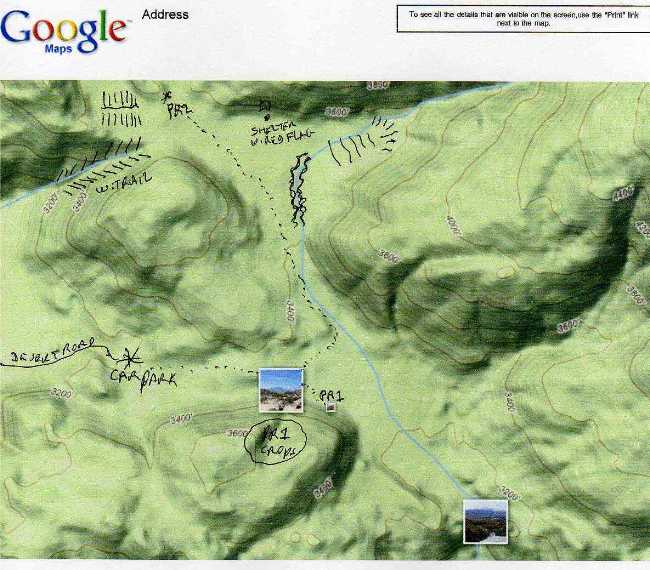 Contour image of upper Little Blair with markings Note in the above image, which shows the little valley above Little Blair Valley, with Pictograph Rock at lower right, and Pictograph Rock 2 at top of valley (PR2), I have drawn superimposed the markings found on Leaning Tower Rock. The horizontal line with verticals on both sides may represent 'irrigated' crops, but this is merely a guess as to where it may have been located. The little valley to the left where I placed it in fact looked flat and capable of sustaining crops in wetter periods (which I suspect was wetter in the past), so this could have been a good location. The little valley opposite has a 'drainage' pattern off the rocks, has a very flat sunken valley there, and could have been used for plantings also. The 'chevrons' pattern is the rockfall down which I climbed back down to Little Blair valley car park. About midway between the 'drainage' pattern and PR2 is a set of cave-like shelters, one of which is marked with a prominent and easy to spot squarish 'red flag' up the rock. The other markings, such as 'ladder' or water flowing are just indicative of what was found in the area. Also, the 'snaking' water may have represented when the arroyos were flowing. (The circle in lower part of map highlights the little valley above PR1 where I suspect the images represented, along with crops and flowing water, and a 'shelter' which may have been a sweatlodge atop a flat rock there.) The dotted line on the map is how I walked from the car park to find these sites. There is one more thing, having slept on it, that seems to now make sense to me: the 'concentric circles' pattern on PR2. This may be how the Kumeyaay Indians represented a pool of water, or water well source. I say this hesitantly, but I remember seeing a similar 'gouged out' pattern on a rock near a desert oasis in the southern part of the park, on approach to Mountain Palm Spring, where there is a year round pool of fresh water. It puzzled me then, but I saw again the same gouged out rock, more like a vertically placed 'mortero', in this little upper valley area near the shelters marked (left of 'shelters' towards PR2), and another one elsewhere. This led me to think these are not natural formations, but indicative to passers-by of long ago that there is a water source nearby. So taking this as a cue, I think the concentric circles pattern is just what it appears to be, a pool of water, or water source nearby, with a small tail showing the water flowing. I would need more field research to confirm this hypothesis, but since atop the large Leaning Tower rock there was a clear depression, which would catch water in ancient times before it split in half, I suspect this may be what those concentric circles meant. It was simply more practical to paint them then gouging them out of solid rock, which is in keeping with the economy the ancient Kumeyaay exhibited in their rock art. So was Kumeyaay rock art magic, in some sense? Yes, I believe it was. The magic was 'water', perhaps not only a graphic depiction of water, its sources, and plantings that benefit from it, but also on a more magical, shamanistic level. I believe, and I don't know why I do, that the representations of water was also a way to call for it. Hence the patterns of clouds and storms in PR1, and the multiple images of flowing water in PR2, are all indicative of what the people in that dry desert were thirsting for. They called their gods to deliver it: Water. There is one more thing, which is puzzling. Why no representations of animals, or hunting, or even people? Puberty rights? Probably not. But this depiction of water related themes shows what a great preoccupation they had with water and plantings, which may have been very difficult in this desert survival, while game was probably plentiful. Or at least it was plentiful enough to not have to incur the favors of the gods to find it, so why bother? Just my opinion of one, but I find it curious, of course. And by default, all the morteros, whether used as grinders on the flat rocks, or vertically placed, were all indicative of their calling down water. But when the droughts came, like at present, the water stopped. Ivan | |||||
Ivan/hand print |
Crop plantings overlay on map, and 'hand print' in Rock Art, continued from above. Today it might rain in the desert around the Borrego Springs CA area (weather page), but I am unable to go, so hope the rains fill some of those valleys at Little Blair with moisture for plants and animals there. However, in looking at those drawing from Leaning Tower rock superimposed on the little upper valley, I think I understand the artist's mind better. On the left side of Leaning Tower rock, above the hand print there are five main drawings that I interpreted as representing features of landscape: 1) the chevron markings overhead center, which may signify the rockfall trail coming down off this upper valley into lower Little Blair valley; 2) the horizontal line with vertical lines off it to the right, which may represent an irrigated crop field in the small valley behind the rock; 3) the 'crown' over horizontal lines on the left, which I interpreted as drainage lines (crown) coming down into a flat area where rows of plantings caught this water; 4) the concentric circles, may signify the 'water bowl' (now cracked) atop the rock; and 5) the double wavy line at bottom center, which I suspect is the part time water flow down the 'arroyo' directly ahead.This is how I overlayed these images on the contour map above. But what intrigues me is how the artist painting these, and standing at the spot where we are viewing them now, was arranging them from his own point of view as to where they should be on the rock. The little valley behind the rock is in fact slightly to the right; the flowing arroyo is directly ahead; the chevron rockfall is to the right of it, just past the little valley with crops; the 'water bowl' atop is atop the rock; and the crown drainage with planting rows is to the left. So from his point of view, that is where they appear on the landscape, and that is how he placed them, approximately, on the rock. It all made sense to put them where he did. The reason I bring this up is because on the southern Pictograph Rock, the point of view from the artist's perspective is from 'above' the valley (at least in part, not totally), not down at the rock, which is how images were place there. (See Aug. 6, 2007: An in situ investigation of Pictograph Rock art: http://www.humancafe.com/discus/messages/6/41.html#POST3981 for earlier analysis) I had written then: But in this case, the artist had in mind to place it from what was 'at hand' directly before him. One wonders if this was not the key to decoding locations, by his leaving his hand print as if to signify that I am seeing it from here? If so, then the artist of long ago (PictoRock2 may predate PictoRock1) left us an important insight into his mind. He was saying "Look over there, and all these things shall be revealed to you, when the rains come." Ivan [BTW, upon further consideration, I think I understand the vertical line with little 'brushes' at either end, next to 'flowing water' line to left of 'chevrons' pattern. Based upon its position to the left of the chevrons (rockfall descending down to larger Little Blair valley), marked with water line (it flows in wet season), the brushes line is most likely a representation of a trail there, on the left side (from artist's pov) of the rockfall. In fact, when I descended there I did finally find a faint trail. And it was to the left of the descending rockfall. The two 'brushes' on either end indicate connected valleys, and the straight line indicates a path. In this case here, because the line is vertical, it may also indicate one valley is above another, which is true here. (It would be interesting to see if this brushy line shows up horizontally when the two valleys connected by a path are over a saddleback of rocks but on the same plane.) These symbols may have been standard in Indian antiquity, though forgotten today by most if not all. This 'key' at Leaning Tower rock may help us unlock it again. What is important about this, if true, is that now we have a key for other rock art, which gives us an opportunity to test the hypothesis with this 'overlay' pattern of the drawings on the landscape. The key, at least in southwest deserts, will be water, but supporting patterns should give indication of travel to and from valleys and villages, and water. That is their 'magical' key to this kind of rock art as found here.] | |||||
anonynous |
Ivan, your Ipi of the Desert story would have been right at home in Little Blair Valley. http://www.humancafe.com/discus/messages/6/23.html#POST4148 Do the Kumeyaay tribes know of your finds regarding their ancient rock art of Anza-Borrego? A reader. Thanks. | |||||
Ivan/Ipi Posted From: 69.228.37.80 |
Dear reader, regarding yours: In fact I had forwarded a copy of the story some months ago, but never got word. I also had contacted them by email regarding Pictograph Rock, but they never wrote back on my interpreting what it said. So, I leave it at that, that the story and rock art interpretations are available, if any finds interest in them. The rest don't matter to me.  Cheers, Ivan | |||||
Ivan/LeaningTower Rock photos |
Leaning Tower Rock - Kumeyaay pictograph photos In my above, http://www.humancafe.com/discus/messages/88/446.html#POST4912 , I sketched what I found on the large Leaning Tower rock in Little Blair Valley of Anza-Borrego desert, and subsequent posts showing correlations between drawings and topographical landscape. Last weekend C. and I went back to the site to take some digital pictures. It had rained a few days earlier and, surprisingly, some of the pictographs were obscured by mineral deposits that had leached down the rock over them. As one can see, the rock art here is much faded, so difficult to capture on film. In the three morteros (just behind C.) there was still a small amount of water left from rain three days earlier; which may mean those morteros were also used as a water gathering device. Also, not unworthy of note, that though on previous trips mine were the only human footprints there, on this hike (about 2 miles from car park) we found many human footprints, some rather new, so this site is now no longer 'unknown'. We did not meet anyone at Leaning Tower Rock, but did see some people visiting Pictograph Rock on the main trail. Here are a few pictures: 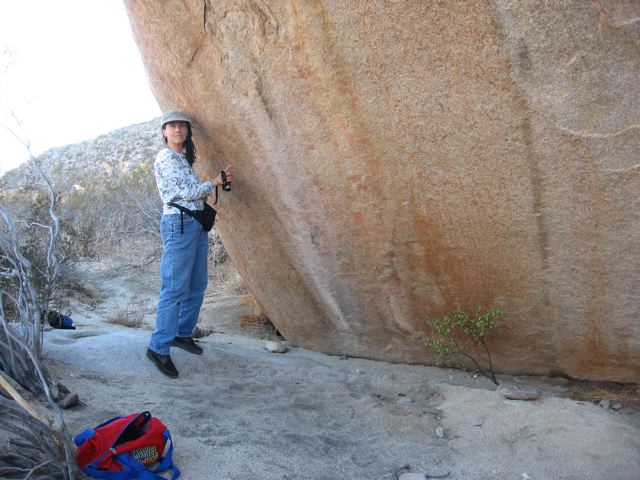 C. standing at Leaning Tower Rock, very faint pictographs difficult to see; morteros behind her.   Faint pictographs on Leaning Tower Rock 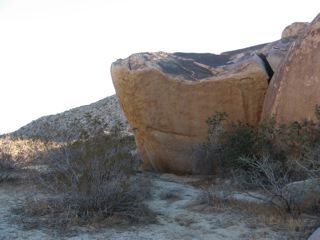  Leaning Tower Rock with 'bowl' atop; daylight fading on short November day We hope to have other photos ready at later date, may need another trip there. Upon further examination, the 'handprint' at lower left was obscured this time by white mineral stain down rock, but small 'heads' on upper right may have been small handprints, though would need better photo technique to capture images. Also need to explore new 'caves' found in small valley just opposite Leaning Tower rock, one large enough to serve as a kiva holding over 20 people.  White mineral stains from recent rain, obscuring images More on these Kumeyaay sites shown here: (5)here, and here too. Ivan Any questions on this Kumeyaay rock art site can be addressed to Ivan at: humancafe@aol.com | |||||
First American Europeans? |
The First Americans were a diverse lot, following the ice. This is a followup on Clovis post above, where early American peoples during the Ice Age may have made it here from Europe, and Asia, along the edges of the ice sheets of the Ice Age some 20,000 years ago. Now there is more evidence that they may have had boats made of skins to make the journey and survive much as the Inuit people had for millennia. See PBS.org American Frontiers with Alan Alda, "Coming into America" series., with more on Clovis here: Solutrean connection. There is now more evidence to show that the Clovis culture came from the Solutrean culture of Europe during the past Ice Age. Can this be true, that Native Americans are a cross gene culture from both Europe and Asia, and perhaps North Africa and Polynesia as well? It is a tempting theory...  (interactive) (interactive) Crystal point, origin unknown, made in the Clovis/Solutrean style Were the First Americans European? - PBS There is still much to be understood about the First Americans, but an Ice Age migration makes sense, down to European DNA, though Asian DNA predominates in the New World. They may have both migrated here in prehistoric times. See also: Out of Europe - First Americans. The idea of a 'proto-European' early settlement of America, c. 20,000 BC, is gaining traction: First Americans: were they Iberian, not Siberian? -- NewScientist (2012)
| |||||
Ivan/Clovis |
The First Americans. The Solutrean-Clovis connection, from France to North America via the Ice Age Atlantic northern borders.
Clovis points of America; Solutrean point from Spain; bifacial Solutrean point (all pictures interactive) I had once written that there was a possibility that some of early America's peoples made it across the ice sheets traveling in Inuit styled boats and kayaks hopping across ice floes, and taking shelter in ice covered bays. (I wrote on this long ago on Humancafe, here's page: http://www.humancafe.com/discus/messages/1/64.html?SaturdayFebruary1420040440pm , see Dec. 14, 2002.) Now nearly five years later, there is new evidence from studying Clovis artifacts of North America, about 13,000-15,000 years ago, that they resemble stone age artifacts in France and Spain, the Solutrean culture of about 15,000 to 20,000 years ago. This PBS Nova program, http://www.pbs.org/saf/1406/segments/1406-4.htm , talks about the connections. Though the Clovis spear point may be an entirely American invention, the America's peoples may have had contact with European travelers, and possibly colonizers, at about the same time during the Ice Age. I suspect this is more likely than we now wish to admit, that peoples in ancient times, even during the Ice Age eras, traveled more than we give them credit for. They were not brutish big game hunters, but opportunists who lived off of whatever was at hand. Mostly, to survive long sea voyages, they would shelter in the ice and feed off the sea's mammals and fish, much as far norther Alaskan native had been doing until recent times. Inuits traveled from Alaska to Greenland this way, a distance of about 2,500 km, same method as described with small boats. The trips took a very long time, maybe months or years, but they did travel. So it is not totally out of line to imagine such travelers in the Ice Age, though the climate was inhospitable, human determination was stronger. If we want to get somewhere, we do. And if word gets back down the grapevine that over there is something worth visiting, we'll go. That's just human nature today, same as it ever was. Here is another article on the same: Immigrants from the Other Side? DNA evidence seems to point to most North American natives as descendent from Asia, with the A,B,C,D genes, but some tribes have an extra X gene that is only found in some people from Europe. This still is inconclusive, but it does open the possibility that America was populated during the Ice Age from both continents. I think the possibility will be shown more real not only with further DNA testing, but with discovery of additional sites of earlier Clovis-Solutrean evidence in North America, especially along the Canadian waterways. One problem is that much evidence which existed during the Ice Age is now burried under 100 meters of water along the southern European and North American coast lines. Human beings are incredibly adaptable even to extreme hostile environments, as the Inuit people show, to extreme cold. It is possible that our clever ancient ancestors traveled the world, even in incredibly inhospitable environments, as long as temporary shelter and abundance of food was present. They could have made it to North America from both Asia and Europe, following the ocean's edge where temperatures were more moderate than extreme, and though early evidence leans overwhelmingly towards Asia, the DNA evidence shows some could have brought their technology with them from Europe as well. That technology of 15,000 years ago then migrated west to the Clovis peoples, if so, or perhaps indigenous to the Americas. Still unresolved, but possibilities now open the northern passage from both West and East to both meet in the Americas. Watch this space for more on this as discoveries come in... See video: Genetic Findings - Halogroup X DNA and HLA Markers (vimeo). Then there is more here: Stone tools 'demand new American story' - BBC Science, Mar. 24, 2011 This just in, BBC: Old American theory is 'speared', Oct. 20, 2011 Ivan The idea of a 'proto-European' early settlement of America, c. 20,000 BC, is gaining traction: First Americans: were they Iberian, not Siberian? -- NewScientist (2012)
Then it gets more complicated: Early rice harvesters in Asia, c. 13,000 BC, looked different from us, with lower brows, jutting chins and wider noses. New human species or hybrids? Could these ancient Asians been early American colonists too? Also see above: First Americans were a diverse lot, following the ice | |||||
Mariner First Americans |
Early Americans were 'ancient mariners' - BBC Science News 
There is growing evidence that ancient 'migrations' from Asia all the way down to South America may have been also accomplished by coastal sea travel, as well as overland. Also see: Easter Island also populated by sea... from the Americas? Southern California's 'Cog-stones' as weights for coastal Indian fishing nets? Did Paleo-Americans cross the Aleutian islands during the Ice Age 25,000 years ago? | |||||
'Singing' Rocks and more on Pictograph Rock |
'Singing' Rocks and more on Pictograph Rock at Blair Valley.  Anthony climbing up little upper valley where Pictograph Rock instructs climbing 'rock ladder', pretty rough climb, could have used those ladders!  Ivan at Pictograph Rock, pointing to natural 'moretero' at bottom of 'ladder' rock-fall, found at 100 paces (we counted!) where climbing trail starts, as described by the 10 vertical/underlined (10x10) rock image. We revisited Pictograph Rock to climb up the small upper valley where the Kumeyaay rock art indicates water and possible plantings during the winter wet season. By late May the area was already bone dry, though upon past visits the soil, which here is more clay than the surrounding sandy desert, was usually moist to the touch. Morteros were also dry, though on past visits they held water. The Indians would have already broken camp by now, heading back up the lower Sierra Mountains, towards Julian and Mt. Laguna, San Diego County. But now, other than a greater abundance of vegetation, and despite recent rains, the little valley was already dry. What crops could they have planted over the short winter/spring season? What did they do with all the stones cropping up, like the 'Devil' stones of New England that surface every spring? They were well littered amidst the vegetation there. Perhaps they planted hardy corn and squash? Perhaps they had more rain in those ancient times, pre-California Mission era, than we get today? Another discovery, unexpected, was at Morteros down the road. We found one of the partially 'scalloped' large horizontal stones to be a 'singing' rock. When tapped with a stone, it emitted a bell-like quality, which could be heard clearly when one puts an ear to it. The only other 'singing' stone I knew of was at the Bowers Museum garden, Santa Ana, CA. This was told to me by David, a retired acoustical space-science engineer. Indeed, here was one that ancient Indians probably enjoyed hearing, long before science sent us into space. Anthony also pointed out new 'red flags' missed on prior visits; also the (leaning) 'tent' pictured on Pictograph may have been closer to the 'pool bath' wash-tub (see link, scroll half down), as a nice and level clear area was right next to it on which to put a sweat-lodge. ![2476,20110520_Ivan_Listening_to_Rock,_Anza_Borrego_[AES]-1.JPG](http://www.humancafe.com/discus/messages/88/2488.jpg) Ivan listening to the tunes of 'singing' stone at Morteros, a natural bell-like sound.  Ocotillio still in bloom, late May, Anza-Borrego desert. Still in search of water, same as the other times, and wondering how to 'prove' Kumeyaay agricultural ingenuity. Perhaps finding low fired pottery shards in the growing fields pictured? Always a fun visit, for its natural beauty and hardy hiking… It was a beautiful and fun day…. We'll be back. Ivan | |||||
More pix of Pictograph2 Rock |
More Pictograph 2 pictures, from Leaning Rock in the upper Blair Valley, also called 'Smuggler's Trail' in Anza Borrego Desert, CA This is follow up of rock art posted earlier: http://www.humancafe.com/discus/messages/6/41.html#POST4913 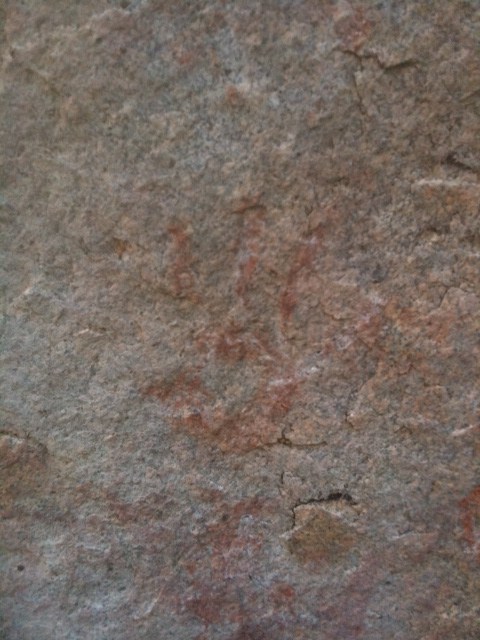 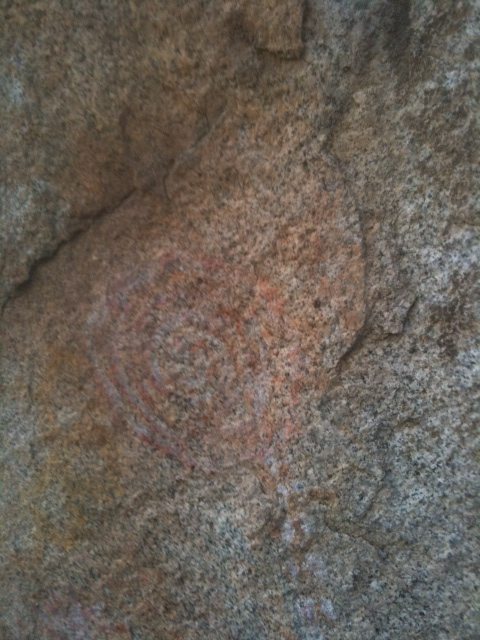 Hand print, there may be three or more of them, all much faded with time; Spiral, may represent water source 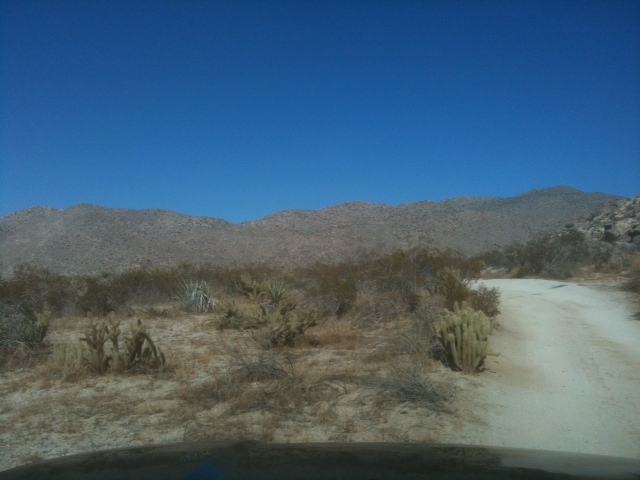  Mountain in background is canyon trail access to upper valley; up an old Indian trail in canyon of mountain 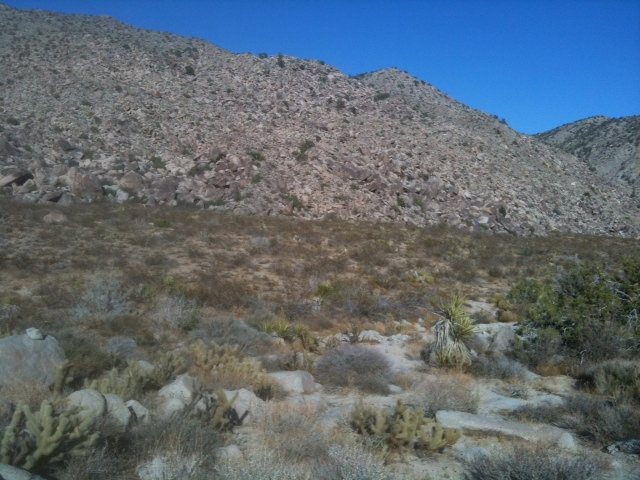  Reaching the upper valley via old trail (it's a long hard climb, but marked with small stacked stones); Barrel cactus on old trail   Rock shelter, one of many in upper valley; image of maybe crop plantings, like squash up valley   Road descending into Anza Borrego (from Julian); Desert sunset   Morteros at Pictographs 2; rock art depicting running water   Large boulder with rock art at Pictograph 2 (dead tree at bottom); enigmatic rock art The images on Leaning Rock Pictographs are much faded, but less so than during wet season. In the dry, lichens and mineral salts seem to have flaked off enough to make images clearer. Unfortunately, the small tree at base of large rock shown in this picture had died of drought. Desert life is tough. And so were the Kumeyaay Indians who lived there centuries ago before the Spanish Missions changed their migration patterns in modern times. One wonders if those hardy souls lived past the age of forty? It would explain their physical endurance to survive in such harsh but beautifully forbidding land. (On this climb in late October it was 34C/93F in the shade, a 'cool' day.) But they were there, they left us messages on their rock art how they did it. Water and plantings were of paramount importance to them. October 22, 2011 (all pix taken with iPhone) | |||||
More pix Anza-Borrego |
More pix of Anza-Borrego desert, Mine Wash road site of important Kumeyaay settlement, with map.   Mine Wash Road; hiking dirt trail past Mine Wash canyon Coming from direction of Julian, CA along Rte. 78, about 2 1/2 miles past campgrounds at Borrego Springs S3 turn off, there is a dirt trail on the right called Mine Wash. Proceeding about 2 miles on trail is the Kumeyaay Indian site, marked with a sign, where they lived during their winter migrations, as evidenced by many stone shards (some pottery shards) littering the ground and 'cave' like habitations in the hills marked with 'red flags'. Then proceed another 3 miles to the end of dirt track, and hike up canyon (requires some light climbing over rocks) for about 1/2 mile through the Pinyon Mountains, and you come to another dirt track at the end. That track takes you down into Shelter Valley along Rte. S2. For PDF map of Anza-Borrego Desert state park see: http://www.parks.ca.gov/pages/638/files/ABDSPmap.pdf 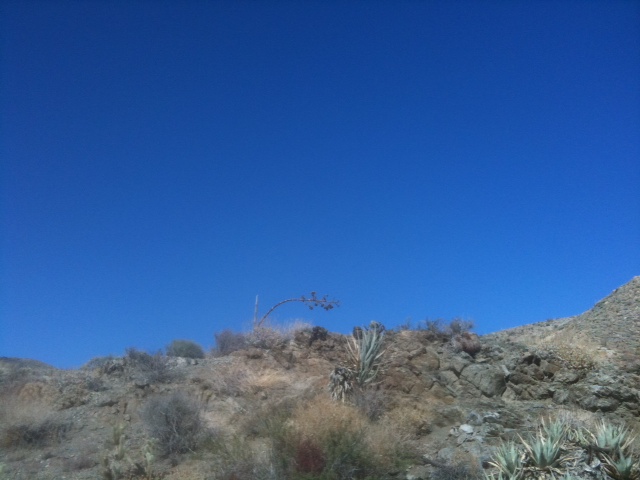  Desert sky blue; rest stop in Pinyon Mountains   Roasting swordfish and squash in desert; desert dessert of green tea and apple (Park rules require metal pan for fires, old turkey pan did fine) 'Thanksgiving day' of fish-and-squash dinner over fire, to honor ancient Kumeyaay Indian spirits, left some offerings of food on a rock… Wonder who will eat it?   Desert lynx tracks (?) saw half buried scat; desert coyote condo? There was a strong feeling of animal life in the Pinyon Mountains, saw tracks of coyote, lynx, big horn sheep, lots of scat, but other than that feeling of 'being watched', only saw birds. The little cave was deep enough for me, there were coyote prints inside.   Making desert tea; serious business cactii  Desert fast rolling into sunset. Best Thanksgiving dinner ever!  | |||||
Kumeyyaay Indian village, eastern slope |
Mine Wash Kumeyaay Indian village, Anza Borrego desert - eastern valley hike  Black gnats were all over my face and neck, biting my eyes and ears It was a hot Labor Day with not a soul in sight, no cars or people, only couple of jackrabbits, some birds, couple of curious bees, one lone hawk… But there were a million gnats! Temperature was about 106F (41C), sunny blue skies, and not as dry as I would have liked. But the great desert solitude was stunningly vast and silent, so I set off to hike from the Kumeyaay Indian village site on Mine Wash road, in Anza Borrego desert, into the valley east of the ancient encampment to see if there was anything there of note. On previous trips we knew the Indians lived there from the many morteros, some pottery shards and stone flakes, half-fashioned arrowheads, and up the rocky slopes some rough living cave shelters. The place may have been inhabited for over a thousand years by the Kumeyaay Indians while in their winter quarters, summers being spent upcountry in the Laguna mountains. But this site holds a special feeling, like the old spirits are still there, so they draw me back about once a year for my desert pilgrimage. This visit was end of summer, and it was still hot. What surprised me, as I had never encoutered before, were the no-seeums gnats that swarmed me as soon as I opened the car door. They were aparently thirsty for my sweat, landed all over my face, eyes, ears, neck and arms. Though I did not know it at the time, they were also hungry for blood, and a day later welts showed up on my face and arms itching like the devil, the worst on my ears. Still, it was well worth the discomfort to hike over into the eastern slopes of the mountain, up a dry arroyo, and feel the tension of heat and exhaustion while trudging the sands. How better to commune with those ancient Indian spirits than to suffer the spectacular beauty of their burning desert? It must have rained recently, as the ocotillo were bright green… and the gnats were numerous! In all, it was a great day.   At Mine Wash road; must have rained as Ocotillos were bright green   Natural 'mortero' showed recent water; tiny desert yellow flowers in bloom My hike lasted only about two hours plus, but I never saw anyone there, so felt the grand solitude punctured only by an occasional breeze through the brush, which felt good on the face and momentarily brushed away the tiny insects that were landing there. Otherwise, it was a long slightly uphill climb up the arroyo the skirted the east flank of the mountain above the Indian village. On two occasions I saw jackrabbits, one bolted but the other posed for me momentarily. Alas, I must have focussed on wrong bush, as its image was not there, or I was too slow to catch him. Part of my hiking there was to ascertain possible signs of Indian habitation, such as more morteros. But if those were dug, in addition to grinding food stuff, also to gather ground water, then there were none visible. On thinking about it, not surprising since 'water morteros' need a level ground absorbing water coming down the mountain, and along the arroyo it was always sloped, so all water would have just continued flowing downhill. Still, I did find something near what might have been an old firepit by the arroyo which was a pleasant surprise. It was a stone tool the kind Indians made long ago, that served as their all purpose 'knife' to either cut or scrape, with a small knotch probably used to straighten arrow shafts. (I had seen one like it in Orange County where there had been a coast Indians village before the Spanish arrival, so immediately recognized what it was, left in situ.) Surpirsingly, it was a very similar design to coastal Indians, which leads me to think the desert clans and coastal clans either traded or had similar artifacts. The one here was of a black obsidian like stone, whereas the coastal one was reddish flint like stone.  Old firepit? But then just as I could no longer stand the heat and gnats, clouds began hovering in, and in the distance I could see lightening. So it was time to go, head back to the car and, mercy, leave those pesky gnats behind. Still, it was a great day. It is hard to describe how it feels out there, always a lingering sense of danger, perhaps on passing a low cave in the mountain side there could have been eyes watching me, turning around frequently to confirm I was not being followed, looking wearily for animal tracks. But there were none, only my own doubling back on themselves on my return. And that vast desert stillness with mountains shimmering in the distance is something words cannot truly describe. It is good to be with the old Indian spirits, goes right to the heart. It was grand.  Desert storm approaching Also see: Deciphering Kumeyaay rock art IDA | |||||
More desert pix |
More pictures from Anza-Borrego Desert, California  Solitude, all alone  Desert sky, perfect day  Desert scene, very dry  Scene while hiking, looking back towards Pictograph Rock  Pictograph Rock  Indian rock shelter  Happy camper  Campfire rock 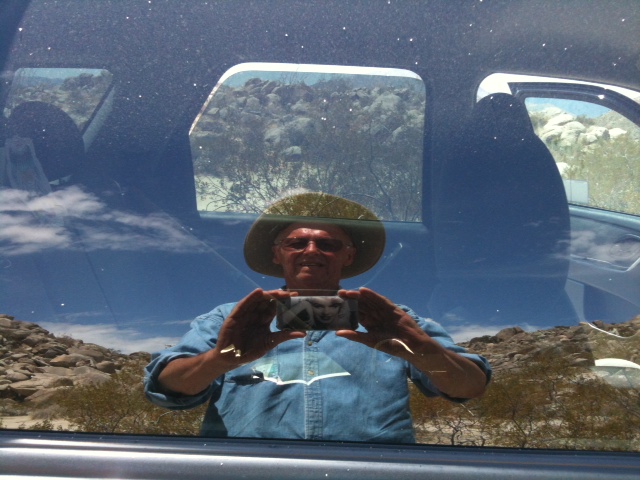 Selfi on hot day in desert  Camp site in Blair Valley It was a hot 4th of July, the desert was totally empty, dry, silent, cherished solitude, just me and the sky and earth, ancient desert spirits, and the few animals who dared to venture and keep me company, a hare, two cotton tails, one vulture, some lizards, and a crow; a perfect day, though very dry it even rained a few drops as I was packing to leave.  Back home that evening the fireworks were astounding! Back home that evening the fireworks were astounding! Ivan | |||||
Kumeyaay tool factory, Anza-Borrego |
Kumeyaay camp site in Anza-Borrego desert, possible tool factory.  End of Pinyon Wash road It may have been a tool making transitory camp for the Kumeyaay Indians living seasonally in the desert. They typically lived in the mountains during the summer dry season, but migrated down to the desert during the winter rainy season. At this site were found the usual rock formations that offered shelter and a few pottery shards, along with what may have been stone hammers and some crudely made stone arrows and scraping tools. 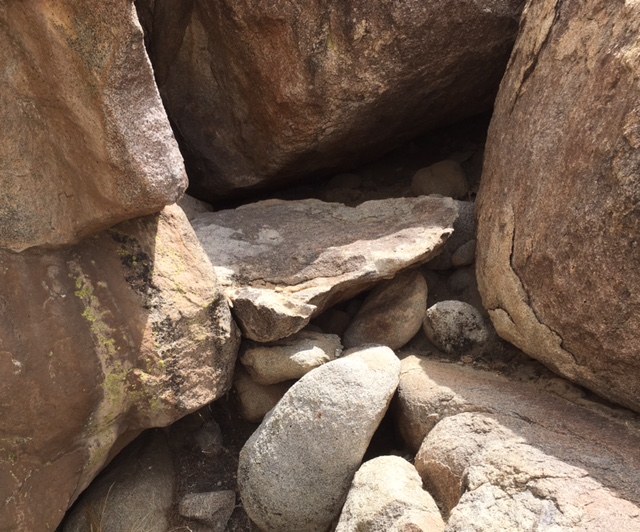 Rock shelter crawl space under boulder The site is at the end of Pinyon Wash road, a dirt track starting about a mile east of Mine Wash on CA-78 in Anza-Borrego State Park. The dirt track meanders south for about five miles, some of it treacherously sandy, so a four wheel drive vehicle is recommended. (Part way into the drive there is a fork in the road, but stay left on the main track.) The desert scenery is spectacular with occasional desert hares and lizards crossing your path. 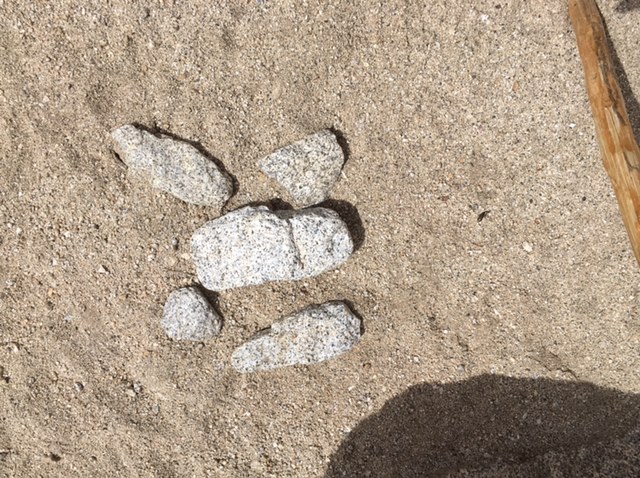 Stone fashioned hammers  Pottery shards and points At the end of the trail is an area large enough to turn around your vehicle, large boulders blocking further progress. Clambering around these large stones reveals typical rock shelters found at other Kumeyaay sites, large enough for two or three to sit inside out of the weather. In one of these someone had left some pottery shards and what may have been stone points for arrows. Nearby were also left in the sand some granite stones fashioned for use as hammers or grinding stones (pix above, all left in situ). However, this site (which is not on the map) had no morteros, which was a bit disappointing. Though there were large stones with artificial depressions gouged in, which may have served as mini-cisterns to collect rare rain of the season. Therefore it is unlikely this was a habitation site, but more likely a tool making camp, which the Indians used only occasionally. Looking around there was evidence of stone flakes and partially made scraping tools and rectangular stones which could have been hammer heads or clubs. The stone here is solid hard, dense, better suited for tool making. There were also large veins of quartz in some of the large boulders, so these may have been also mined for their tool making. At other sites in the desert there were morteros carved into more porous large rocks at base of mountains, which other than serving as grinding holes also had the ability to absorb ground water through capillary action, so they filled with water during the wet season. At this site instead were the mentioned gouged rock 'cisterns', which were a poor substitute but could provide water occasionally after rain. Naturally, as they had pottery, they had means to store and carry water. I looked for any pictographs, such as found at upper Blair Valley leaning rock, but found none.  Gouged rock to collect rainfall  Possible cistern gouged out The weather late July was surprisingly pleasant, hot but not oppressive, a light breeze. It had rained a little earlier that day, some moisture was evident but no accumulation. The desert flora looked healthy. Never saw another soul there, so experience gave a special feeling of total solitude and that desert big silence. There was coyote scat, as well as big horn footprints, and the interior of rock shelters showed evidence these were used by them, probably for sleeping out of the sun; none were evident when I was there. But the 'tool factory' find was a pleasant surprise. You will need good undercarriage clearance for this dirt track, low slung autos may get hung up, so beware. There are good hikes in the area, such as Big Horn Canyon. Always leave artifacts in situ and bring lots of water.  Dirt sandy track IDA | |||||
Ivan Alexander Username: Humancafe Registered: 12-2017 |
Old Indian trail up canyon from Blair valley to Little Blair valley, Anza Borrego desert. (Continued from 9/28/2008 visit)  Selfie after the fall at Indian bench on old trail 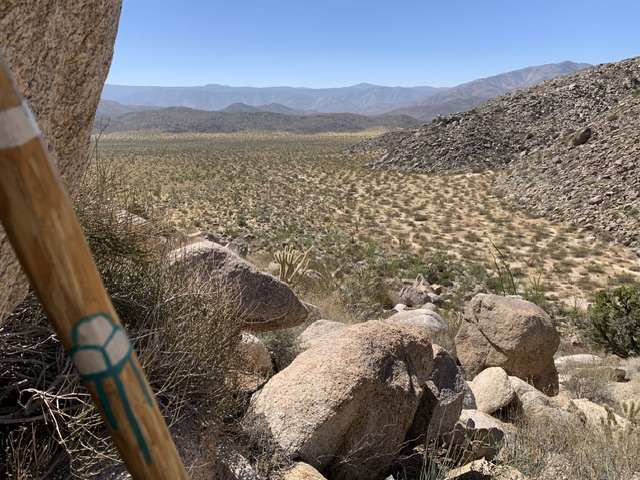 View of valley below 'bench' 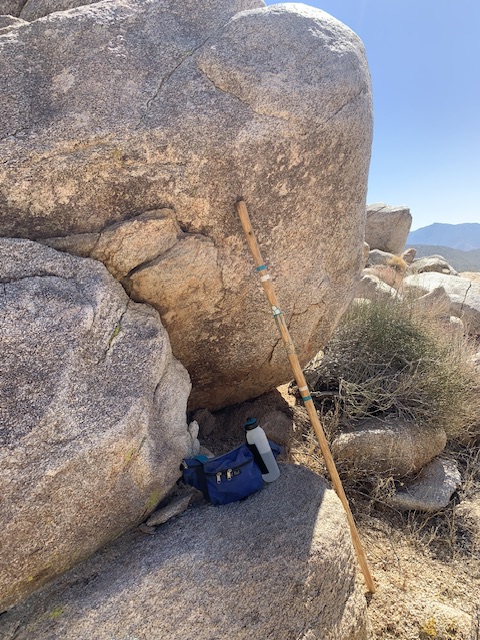 The bench rest stop on trail On a recent visit, 9/12/2024, after many years since I had found the old Indian trail up the canyon, it had become more difficult with loose rubble and overgrown with cacti and spiky agave, so a hard climb (I even got lost off trail), but it is still visible. The rock with built in 'bench' overlooking the canyon was about 200-300 meters up from the start of the trailhead below. After a bad fall that split my cheek, elbow and knee, with cacti spines stuck in my arms and legs, the old 'rest stop' was a welcome respite from the hot sun and hard climb. Note: Proceed with great caution. This very faint trail is very difficult climbing, treacherous with loose rock and spiny plants and cacti, but more manageable coming down from Little Blair, though still slippery and rough. There were stone piles markers at the lower trailhead and at stone 'bench' but these may have fallen with time. It's a beautiful climb but hard, bring First Aid, sturdy walking stick, and plenty of water and energy snacks. Best to bring a hiking buddy. IDA |


